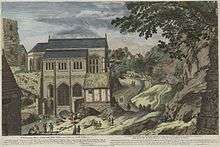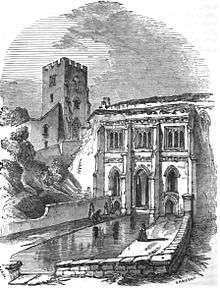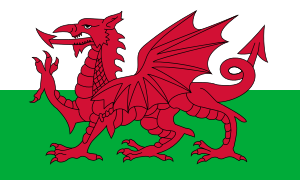St Winefride's Well
St Winefride's or Winifred's[1] Well is a well located in Holywell, Flintshire, in Wales. It claims to be the oldest continually visited pilgrimage site in Great Britain[2] and is a grade I listed building.
The well is believed to be connected to St Mary's well and chapel in Cefn Meiriadog, Denbighshire. It is one of the few locations mentioned by name in the anonymous medieval alliterative poem Sir Gawain and the Green Knight.
History


The healing waters have been said to cause miraculous cures. The legend of Saint Winifred tells how, in AD 660, Caradoc, the son of a local prince, severed the head of the young Winifred after she spurned his advances. A spring rose from the ground at the spot where her head fell and she was later restored to life by her uncle, Saint Beuno. [4][5]
The well is known as "the Lourdes of Wales" and is mentioned in an old rhyme as one of the Seven Wonders of Wales. It has been a pilgrimage site since the 7th century.[6]
After a shrine was established in Shrewsbury around 1138, it and St. Winefride's Well (from her name's Latin spelling) became important pilgrimage destinations.
Richard I visited the site in 1189 to pray for the success of his crusade, and Henry V was said by Adam of Usk to have travelled there on foot from Shrewsbury in 1416.[5]
In the late 15th century, Lady Margaret Beaufort had built a chapel overlooking the well, which now opens onto a pool where visitors may bathe.[5]
Some of the structures at the well date from the reign of King Henry VII or earlier. Later, King Henry VIII caused the shrine and saintly relics to be destroyed, but some have been recovered to be housed at Shrewsbury and Holywell.
In the 17th century the well became known as a symbol of the survival of Catholic recusancy in Wales.[7] From early in their mission to England, the Jesuits supported the well. In 1605, many of those involved with the Gunpowder plot visited it with Father Edward Oldcorne to give thanks for his deliverance from cancer, or as some said, to plan the plot.[8]
James II is known to have visited the well with his wife Mary of Modena during 1686, after several failed attempts to produce an heir to the throne.[5] Shortly after this visit, Mary became pregnant with a son, James.[5]
Princess Victoria, staying in Holywell with her uncle King Leopold of Belgium, visited the Well in 1828.[9]
Gallery of images
-

Interior of St Winifreds Well c.1781
-
.jpg)
Interior of St. Winifred's Well, 1813
-
View from the entrance to the site
-
The source of the water
-
Hand-pump by the bathing pool, providing drinkable water from the source
-
Inscription left by someone who was cured
-
Decoration at the top of a pillar showing man carrying a disabled companion
-
Candles burning in front of a statue of St Winefride
See also
References
- ↑ e.g. Toby Barnard, "Triangular Lives", Times Literary Supplement, 20 June 2008 page 11.
- ↑ VisitFlintshire.com
- ↑ Chambers, Robert (1832). The Book of Days: A Miscellany of Popular Antiquities in Connection with the Calendar, Including Anecdote, Biography, & History, Curiosities of Literature and Oddities of Human Life and Character, Volume 2. London: W. & R. Chambers Limited. Retrieved 7 January 2016.
- ↑ Holywell Tourist site
- 1 2 3 4 5 Alexander, Marc (2002) A Companion to the Folklore, Myths & Customs of Britain, Sutton Publishing, pp. 264–265
- ↑ BBC. "Seven wonders of Wales".
- ↑ Toby Barnard, "Triangular Lives", Times Literary Supplement, 20 June 2008 page 11.
- ↑ Lives of the Saints By Alban Butler, Peter Doyle, ISBN 0-86012-253-0
- ↑ Royal pilgrims visitors
Further reading
- T. W. Pritchard. St Winefride, Her Holy Well and the Jesuit Mission c. 660–1930. Bridge Books, 2009.
External links
- St Winefride's Well – official site
- Holywell Tourism: St Winefride's Well
- St Winefride's Holy Well
- St. Winifred's Well information at Castlewales.com
- Notes on the site's history including souvenir postcards featuring heaped pilgims' crutches left behind after miraculous cures
Coordinates: 53°16′38″N 3°13′25″W / 53.2771°N 3.2236°W

